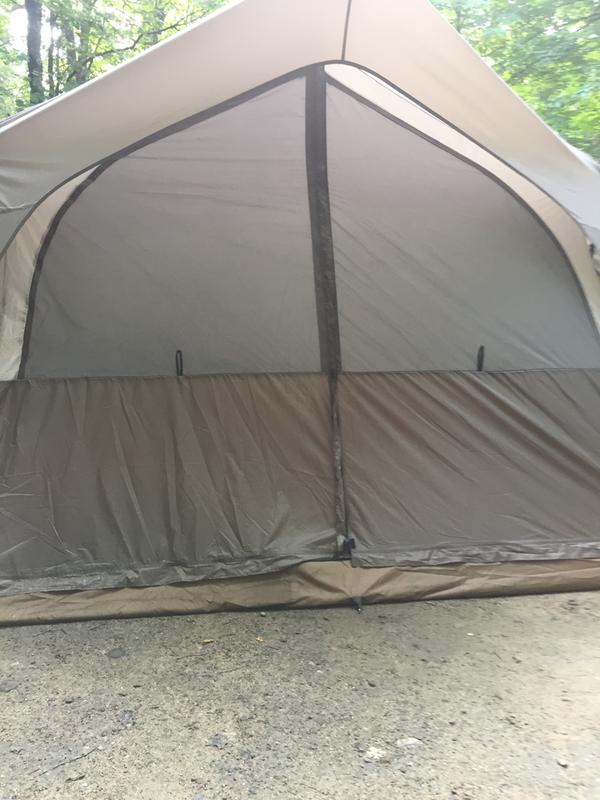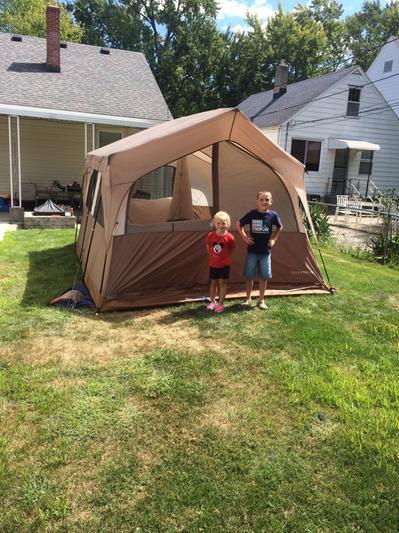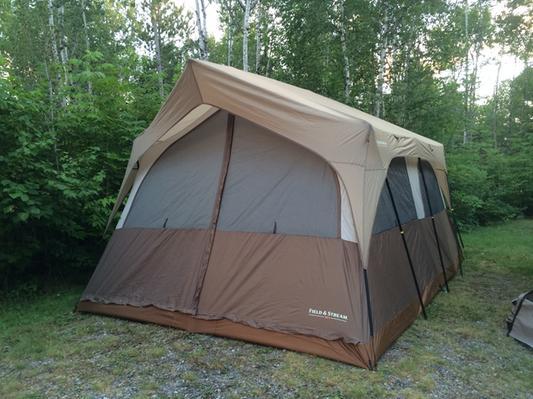Turn the versatile Field & Stream® Wilderness 10 Person Cabin Tent into your home away from home! With room for five people in the main body of the tent, and up to five additional people or equipment in the screened entrance, the Wilderness Cabin has space for everything you need.Strangely the Camp Master Lagoona Diner 5 cabin tent appears to be the exact same design
Field & Stream Wilderness Cabin 10 Person Tent - well it's a little better design, as I explain below.So if you're wondering how to put together the Field & Stream 10 person cabin wilderness lodge tent - then watch this vid on the Camp Master Lagoona Diner Cabin 5 assembly
I used a Campmaster Lagoona 5 (2 rooms and a verandah with mozzie nets and side panels). Not a turbo type, but the design meant I could get it up myself in 15mins flat. Used it in all sorts of weather for years and never had a problem, as long as I pitched it properly and had a big enough gap with the flysheet.What is quite funny is that the Field & Stream 10 person cabin tent had a "pricing error" online whereby it sold for $29.99 instead of $199.99.
They don't cost a fortune either.
Anyway apparently a few people actually got the tent for $30 instead of $200!!
So the plan is for this to be my house from spring to fall.
My "Camp Cabin" tent from Kelty was an "experimental design" - and so there was too much tension in the poles. I was not the only one who kept having the poles break. So I think that model got discontinued due to bad reviews. Still it was an awesome tent. I used it for two years but when the zipper broke and the 2nd pole broke - I just left it up. Then the elements (snow) have destroyed the tent. I maybe able to still use it in some capacity. But the main aspect of a cabin tent is you can stand up - to do moving active qigong away from the very thick mosquitoes.
So what I like about this design - is it has 2 rooms - so I am bound to get mosquitoes in the first room. The Camp Cabin had just one room and so I spent quite a bit of time killing mosquitoes - and getting blood stains in the tent. Having 2 rooms enables one more escape hatch as it were - to cut down in the critters getting after me.
So the Lagoona Cabin 5 has the same "two room" design - with the front room as a screen. Also it's the same size - each room is designed for 5 people - so it's a 10 x 15 size in total, each room is 7.5 x 15 (again this is the same dimensions as the Field & Stream). So that's just too close to be a coincidence! I think the companies are based on different countries?
The front section is a Gazebo type room with out a bath tub like groundsheetOK again that is the SAME "limitation" as the Field & Stream 10 person tent!!
A four-season tent needs to be sturdier to withstand storm-force winds and snow loads, so will have more and thicker poles, plus tie-outs to help anchor the structure. Many four-season tents have large screen sections that can be closed off when necessary, making them adept at all-season use.
Wow hilarious. The Lagoona Cabin 5 has the SAME pole system - but all fiberglass poles. While the higher priced "dome" cabin tents also have fiberglass poles (that break easily!) Except for 2 dome cabin tents below - the Cedar Ridge Rimrock and the Browning Big Horn Tent have fiberglass on top for the roof and steel on the sides). People like that "easier" set up style I guess of fiberglass "dome" poles or think the "dome" geometry will be stronger in the wind or something. No way! I would much rather have all steel poles over fiberglass.
the Cabin 5 and the thing just wasnt waterproof at all,
Ideally you want a ‘chimney’ effect, in which cool air is drawn in near the floor, and warm, moist air rises naturally and exits via high vents. Tunnel-shaped tents with one end higher than the other excell at flow-through ventilation; dome tents with no peak vent are very poor at it.Right - so I bought silicone spray to improve on the water proofing. Plus I'll try to hang tarps over the tent. I have tarps but they got taken down in the snow. I should be able to recover them. The Field & Stream tent says to seal the stitched seams on the inside - but some of the seams are taped. So I gotta look into the seam sealers - and see what part is not taped, etc. So I'll spray the inside seams with the silicone - the stitching. Silicone is used as a seam sealer and is non-toxic.
I sprayed the rain fly and bottom portion of the tent with a silicone water proofing just to be safe, but I've always done that. A wet tent is never fun, another lesson I learned the hard way.
Nylon is stronger by about 15 percent, and more elastic. However, it is also much more susceptible to UV degradation, and is hygroscopic—the fabric absorbs (and chemically bonds to) water. Either will work, but overall, unless nylon is expensively silicone-coated (see below), polyester is probably superior.
The former employ polyurethane, which is applied to the underside of the fly. Why the underside? Because polyurethane is even more susceptible to UV degradation than the material. To keep the fabric above the coating from being soaked (and to add a bit of UV protection), it is coated on top with a DWR (durable water-repellent) treatment, usually a fluoropolymer applied at the production stage. Unfortunately the ‘durable’ bit is misleading: DWR coatings wear off rapidly with use. When this happens, the polyurethane will still keep the tent underneath dry, but the fly will soak up water, which in the case of nylon will induce stretch that compromises a taut pitch, and in either case will facilitate the growth of mold if not thoroughly dried.
A silicone-treated flysheet is so water repellent that a good shake will leave it practically dry. Some manufacturers combine a polyurethane coating on the underside of the fly with a silicone treatment on top—much better than PU/DWR, but not as good as double-impregnated silicone. Downsides? Cost—significantly higher than PU—and the fact that seam tape will not adhere to silicone; seams must be sealed with liquid sealant (you’ll need special repair tape for tears as well, although tears will be less likely in the first place, and less likely to migrate). It would not be exaggeration to say that if the fly of your tent is double-silicone-treated nylon or polyester, you can pretty much be assured the rest of the tent will be first-class as well.
So the pdf on the specs of this Camp Dry silicone spray - it's mainly Naphtha petroleum! 60% to 100% - so I'm gonna spray that stuff on the OUTSIDE of the tent - In Ancient Greek, it was used to refer to any sort of petroleum or pitch.
The most convenient,and most expensive, is a product called "Camp Dry" which is made by Kiwi (yes, the shoe polish people) and distributed through chains like Kmart. It comes in an aerosol can and covers, if memory serves, about 200-250 square feet per can. It has a distinct kerosene-like odor when applied, which mostly disappears with use. Since it doesn't saturate the threads of the fabric, it probably doesn't do much damage to the fire-retardant properties of the cloth or its ability to "breathe" (that is, allow water vapor to pass through the cloth).
What makes the PU-coating of value is the fact that water vapour can slowly diffuse through it, and this makes the fabric 'breathable'.
the silicone in silnylon completely permeates the fabric fibers - it can't peel off. But remember: it does not breathe!
When your tent is new the nylon or polyester on the fly, floor or walls has what is known as a Durable Water Repellency or DWR. This is applied to the actual threads and is separate from the urethane coating on the underside of the fabric. The DWR causes water to bead up and run off similar to the wax finish on a car. As the tent is used or through age the DWR breaks down and allows water to stay on the fabric where it can seep through any breaks or abrasions in the urethane coating. Silicone renews the DWR so that water beads up and runs off before the water has a chance to find any breaks or cracks in the urethane. Silicone usually needs at least 2 coatings to be most effective but follow all directions with the product you are using. Silicone is to be applied to the outside or the uncoated side of the fabric; it will not work if applied to the underside or the urethane coating.
I would not recommend using a silicon-based spray on tents ot tent flys. The carriers used in liquid silicon products can worsen the effects of UV rays on synthetic materials. Instead I recommend using a polymer-based treatment like Gore's Revivex or Nikwax's TX-direct.
naphtha octane number is improved when exposed to UV rays But the silicone is waterproof while these "water repellents" are not as effective.........................
It rained every day we were there and the tent corners leaked. I had to keep wiping it. The seems [sic] were leaking, I took pictures and video to show. The top holds water and we had to keep pulling it to get the water to drain off also. I inspected all the seams and they looked like they were pulled too tightly because you could see the tiny holes in them.
When nylon gets wet, it absorbs water and expands 3.5% in length (2% for nylon 6,6 - "high tenacity nylon").
 |
| Someone says their Field and Stream stayed dry in the rain |
Yeah I guess Camp Master tents are based out of South Africa.
So you can see the 10 person cabin tent - this lodge pole design - really is like a cabin canvas tent.
Another assembly vid of the Lagoona Diner Cabin 5 tent - with narration for instructions
OK it's not precisely the same - but close enough.
And the front screen porch on the Field & Stream actually enables closing up the side screens.
So hence it is more "water proof" compared to the Lagoona Diner Cabin.
Here is a 3rd camp cabin that is 10 x 14 on youtube
The problem with that dome tent design is the walls are not as vertical - so you lose space.
Here is another 2 room cabin tent - again similar design - the walls are not as vertical
3rd version of same 2 room cabin tent with the walls not as vertical - undergoing rain testing! vid
Right - it comes in the SAME kind of bag (with the assembly instructions sewn in the side)
So yeah these are probably all made in the same factory in China and just "varied" a bit for each company. Hilarious. So the Browning tent has a screen top - so it will get less condensation. The price though is almost twice as much.
It's not as tall as well. This Field & Stream is over 7 feet tall.
Nicely wide.
The only thing - someone recommended attaching something to the rainfly so it doesn't drip on the windows.
So like plastic or duct tape and pull out the rainfly on the sides.
OK I get it - this is based on a Sears design. I think we had this design as a canvass tent.
Two rooms each 7 x 10 feet.
So it's called a Hillary tent after Sir Edmund Hillary - but originally Sears sold them as canvass tents (vid).
In this newer cabin tent the "ridge pole" is longer along the vertical - instead of horizontal along the "wall."






No comments:
Post a Comment